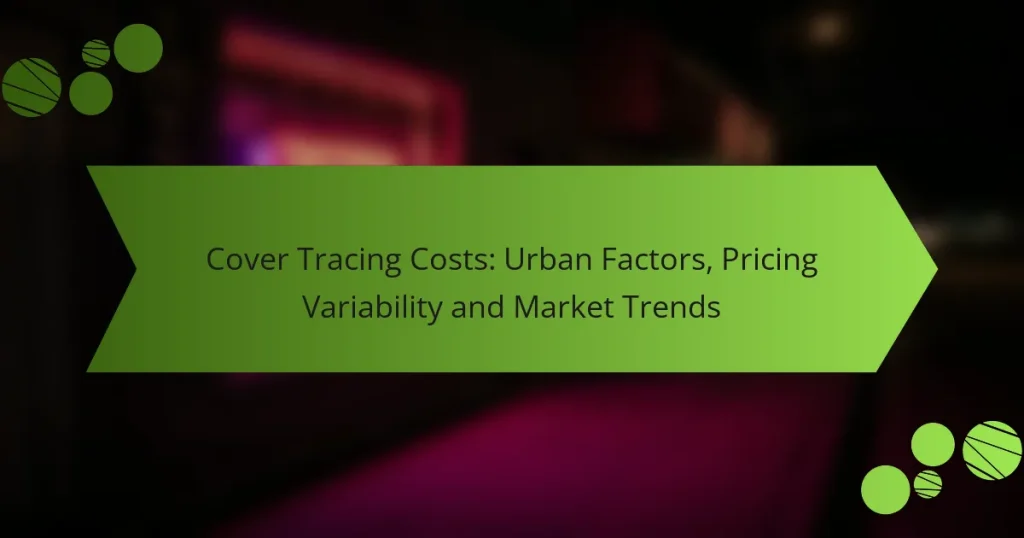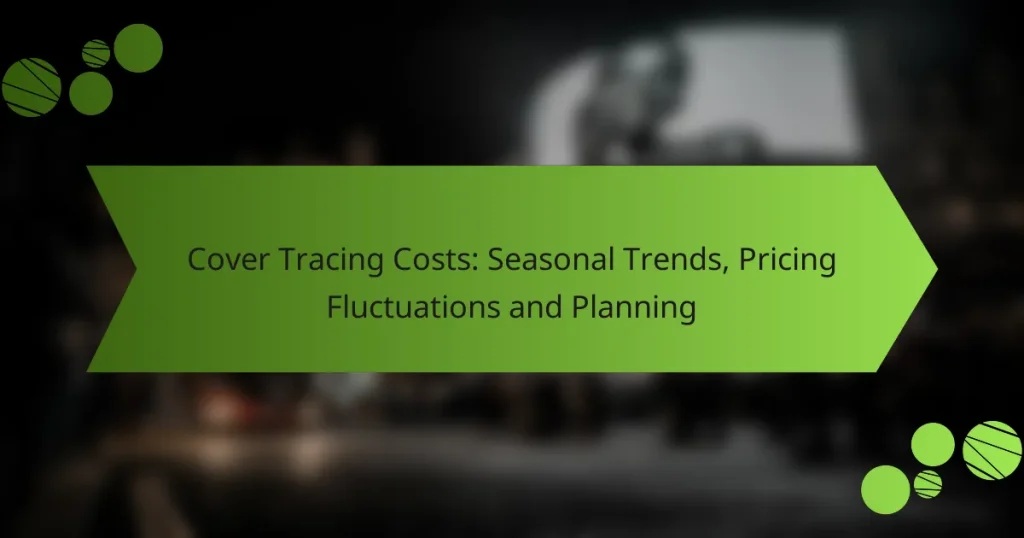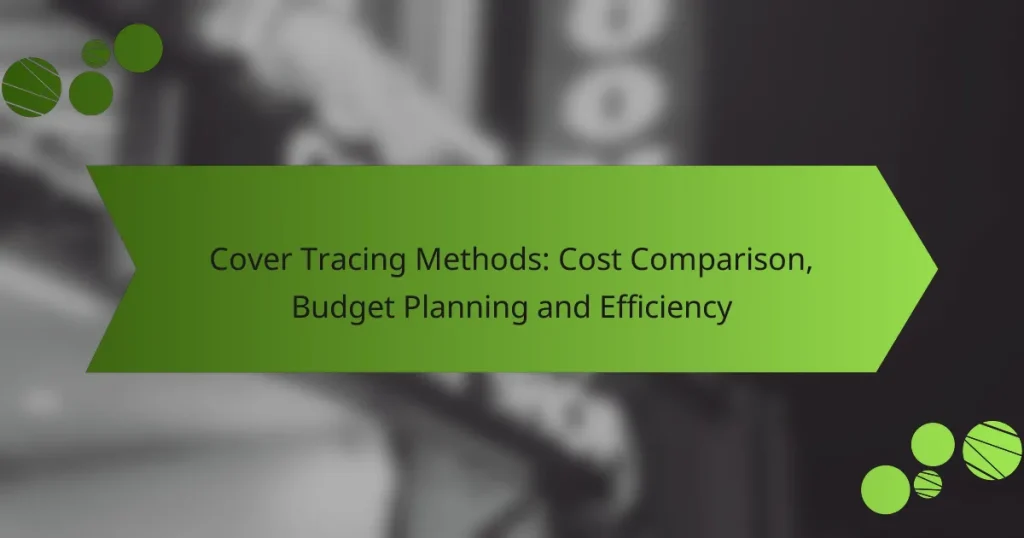Evaluating cover tracing costs is crucial for understanding the financial implications of locating individuals or assets. In the United States, these costs can vary widely, influenced by factors such as property type and tracing complexity. Choosing the right service provider involves assessing their experience, success rates, and the technology they employ to ensure effective and efficient results.
Cover Tracing Costs: Seasonal Trends, Pricing Fluctuations and Planning
Cover Tracing Methods: Cost Comparison, Budget Planning and Efficiency
Cover Tracing Budgeting: Homeowner Strategies, Cost Management and Planning
Cover Tracing: Hidden Costs, Project Scope and Financial Planning
Cover Tracing: Cost Estimation, Budgeting and Renovation Impact
Cover Tracing: Material Choices, Cost Implications and Quality
What are the average cover tracing costs in the United States?
The average cover tracing costs in the United States typically range from a few hundred to over a thousand dollars, depending on various factors. These costs can vary significantly based on the type of property and the complexity of the tracing required.
Cost range for residential cover tracing
For residential cover tracing, costs generally fall between $300 and $800. This range can be influenced by the size of the property and the specific services needed, such as locating underground utilities or assessing property boundaries.
Homeowners should consider obtaining multiple quotes from service providers to ensure competitive pricing and to understand the scope of services included in the estimate.
Cost range for commercial cover tracing
Commercial cover tracing costs are usually higher, ranging from $800 to $2,500 or more. The increased complexity of commercial properties, which may involve larger areas and more intricate systems, contributes to this higher cost.
Businesses should evaluate the potential return on investment when considering cover tracing services, as accurate tracing can prevent costly disruptions and legal issues down the line.
Factors affecting cover tracing costs
<pSeveral factors can influence the cost of cover tracing, including the type of property, the location, and the specific services requested. For instance, urban areas may have higher rates due to increased demand and operational costs.
Additionally, the experience and reputation of the service provider can impact pricing. Choosing a well-reviewed company may result in higher upfront costs but can lead to better accuracy and reliability in the long run.
How to evaluate cover tracing service providers?
To evaluate cover tracing service providers, consider their experience, success rates, and the technology they use. It’s essential to assess their reputation in the industry and the specific services they offer to ensure they meet your needs.
Key criteria for selection
When selecting a cover tracing service provider, focus on their track record and client testimonials. Look for companies that have a proven history of successfully locating individuals and assets, as well as those that utilize advanced tracking technologies.
Additionally, consider the cost structure. Some providers charge flat fees, while others may operate on a commission basis, which can vary significantly. Understanding these financial aspects will help you make a more informed decision.
Top-rated cover tracing companies
Several cover tracing companies are recognized for their reliability and effectiveness. Companies like LocatePlus, TLOxp, and Experian are often cited as top choices due to their comprehensive databases and advanced search capabilities.
When comparing these companies, evaluate their pricing models, customer support, and the specific tools they offer. For instance, some may provide real-time tracking updates, while others might focus on detailed reporting after the fact.
What are the benefits of professional cover tracing?
Professional cover tracing offers enhanced accuracy and efficiency in locating individuals or assets. By leveraging expert knowledge and advanced tools, these services can significantly reduce the time and effort required for successful tracing.
Accuracy and reliability
Accuracy is a primary benefit of professional cover tracing. Experts utilize comprehensive databases and investigative techniques to ensure that the information gathered is reliable and up-to-date. This minimizes the risk of pursuing false leads or outdated contacts.
For example, professional services often have access to proprietary data sources that are not available to the general public, allowing them to verify identities and locations more effectively. This level of precision is crucial, especially in legal or financial contexts where incorrect information can lead to significant consequences.
Time efficiency
Time efficiency is another key advantage of using professional cover tracing services. Experienced professionals can complete tracing tasks in a fraction of the time it would take an individual to do so on their own. This is particularly beneficial for businesses or legal entities that need quick results to make informed decisions.
Typically, a professional tracing service can provide results within days, compared to weeks or even months for self-conducted searches. By outsourcing this task, organizations can focus on their core activities while ensuring that tracing is handled promptly and effectively.
What are the common pricing models for cover tracing?
Cover tracing typically employs several pricing models, each with distinct advantages and considerations. The most common models include flat-rate pricing, hourly rates, and per-project pricing, allowing clients to choose based on their specific needs and budget constraints.
Flat-rate pricing
Flat-rate pricing involves a fixed fee for cover tracing services, regardless of the time or resources required. This model is beneficial for clients who prefer budget certainty, as they know the total cost upfront.
However, clients should ensure that the scope of work is clearly defined to avoid unexpected charges. For example, a flat fee might range from a few hundred to several thousand dollars, depending on the complexity of the tracing task.
Hourly rates
Hourly rates charge clients based on the actual time spent on cover tracing, making this model flexible for varying project scopes. This approach can be advantageous for projects that may require adjustments or additional work as they progress.
Clients should be aware that costs can accumulate quickly, especially for complex cases. Rates can vary widely, typically ranging from $50 to $150 per hour, depending on the expertise of the service provider.
Per-project pricing
Per-project pricing sets a fee based on the entire project rather than hourly work, similar to flat-rate pricing but often tailored to specific project requirements. This model allows for detailed customization and can be beneficial for larger or more complex tracing tasks.
When considering this model, clients should discuss all project details upfront to ensure the price reflects the expected workload. Typical project fees can range from a few hundred to several thousand dollars, depending on the project’s scale and intricacy.
How does location impact cover tracing costs?
Location significantly influences cover tracing costs due to variations in labor rates, regulatory requirements, and market demand. Costs can differ widely between urban and rural areas, as well as among different states, affecting the overall expense of cover tracing services.
Cost variations by state
Cover tracing costs can vary considerably from state to state, influenced by factors such as local labor costs and state regulations. For instance, states with higher living costs, like California or New York, may see prices in the range of $100 to $200 per hour, while states with lower costs, such as Arkansas or Mississippi, might charge between $50 and $100 per hour.
It’s essential to research specific state regulations that may impact pricing, as some states have mandated minimum fees or specific licensing requirements that can add to the overall cost. Always obtain quotes from multiple providers to ensure competitive pricing.
Urban vs. rural pricing differences
Urban areas typically have higher cover tracing costs compared to rural locations. This is often due to increased demand for services and higher operational costs in cities. In urban settings, prices can range from $100 to $250 per hour, while rural areas might offer rates as low as $50 to $80 per hour.
When considering cover tracing services, evaluate the trade-offs between cost and accessibility. Urban providers may offer faster service due to proximity, while rural providers might take longer but offer more competitive rates. Always weigh the urgency of your needs against the potential savings.
What are the emerging trends in cover tracing?
Emerging trends in cover tracing focus on technological advancements and shifts in market demand. These trends are reshaping how businesses approach cover tracing, affecting costs and efficiency.
Technological advancements
Technological advancements are significantly enhancing cover tracing processes. Innovations such as artificial intelligence and machine learning are enabling faster data analysis and more accurate tracing of coverages. These tools can automate repetitive tasks, reducing the time and labor costs associated with manual tracing.
Additionally, cloud-based platforms are becoming popular, allowing for real-time collaboration and access to data from anywhere. This flexibility can lead to improved decision-making and quicker responses to market changes.
Market demand shifts
Market demand shifts are influencing the strategies companies use for cover tracing. As consumer preferences evolve, businesses must adapt their offerings to meet new expectations, which may require more comprehensive coverage options. This shift often leads to increased competition, driving companies to enhance their tracing capabilities to stay relevant.
Furthermore, regulatory changes in various regions can impact demand for specific types of coverage. Companies need to stay informed about these regulations to ensure compliance and avoid potential penalties, which can add to overall costs.






